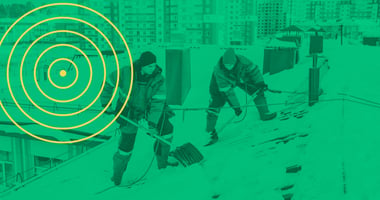As extreme weather events become increasingly common, the climate resilience of infrastructures has...
What Is Condition-based Building Maintenance?

Maximizing the lifespan of your building while guaranteeing the safety of the occupants is a priority in building management. Maintenance can be costly, and it's not always easy to determine the right time to carry out inspections, renovations or other interventions... or to switch to connected maintenance!
If you're a building maintenance manager or owner, and you're involved in reactive maintenance, you may be wondering what the next step is for you. You're not alone! This article will help you understand what condition-based maintenance is, its advantages and disadvantages, and how it differs from reactive and preventive maintenance.
Canadian Buildings
According to the Government of Canada, the vast majority of the country's 560,000 commercial and institutional buildings are expected to still be in operation in 2050 (1), and building upgrades will need to be significant (2). So what if aging buildings represented an opportunity to shift paradigms and adopt condition-based maintenance to make investments more profitable in both the short and long term? Although Canada has a relatively young building stock compared with some European countries, many buildings are approaching or exceeding their expected service life. This underlines the growing importance of modernizing assets to maintain and even improve their energy efficiency (3), structural integrity and overall function.

Climate change is accelerating the ageing of buildings, and is requiring them to be reinforced. This includes the ability to withstand extreme weather events such as floods, forest fires, earthquakes and severe storms. Disasters affecting buildings are becoming more frequent and more intense. Thanks to technological advances such as intelligent sensors, it is now possible to monitor critical variables in real time, so that action can be taken before any consequences occur.
Climate change also affects building comfort and safety, for example with prolonged periods of extreme temperature. A case in point is the heat dome in Western Canada in 2021 (4), still Canada's deadliest weather phenomenon to date. Analyses showed that it was the heat inside the homes that contributed most to the deaths, as opposed to the heat outside. With condition-based maintenance, it is possible to measure the exact temperature in the various rooms of a building to ensure that they do not exceed critical thresholds for the health of occupants.
How Does Condition-based Building Maintenance Work?
Conditional maintenance uses sensors and monitoring systems installed on relevant building equipment or components. These can be found on HVAC systems, elevators, roofing, lighting, roof drains, or in strategic locations to measure temperature, humidity or mold risk for example.
The devices continuously collect data on parameters such as temperature, vibration, energy consumption and other performance indicators. Machine learning and artificial intelligence then identify patterns, trends and anomalies that could indicate potential problems, and even cost-saving opportunities.
It's at this point that the maintenance team can determine the best time to intervene, proactively and based on data. And as time progresses, results are optimized, as the amount of data increases.
What's the Difference Between Reactive Maintenance, Preventive Maintenance and Condition-based Maintenance?
Reactive Maintenance
Reactive building maintenance, also known as corrective or curative maintenance, is a maintenance strategy in which we intervene only when a problem occurs in a building. For example, we would unclog our roof drains when we notice water infiltration.
Advantages :
-
Simple operation.
-
Low initial cost, as no process is required.
Disadvantages :
-
Higher lifetime costs due to costly unanticipated repairs.
-
Unforeseen downtime that can halt building operations.
-
Potential safety risks.
For example, the detachment of building facades can pose a safety risk to people passing nearby, just as the collapse of a roof under the weight of snow can endanger building occupants. In these situations, reactive maintenance is not the cause of the problem, but it does not prevent these dangers either.
Preventive Maintenance
Preventive maintenance is a proactive approach that involves regular time-based inspections, repairs and maintenance to avoid breakdowns and failures in a building's infrastructure. For example, we would check our roof drains for clogging every season.
Advantages :
-
Reduce long-term costs by minimizing emergency repairs and premature replacements.
-
Increased reliability and safety by detecting and correcting problems before they become critical.
-
Optimized performance thanks to well-maintained equipment.
-
Increased building lifespan.
Disadvantages :
-
Higher initial costs with the implementation of a preventive maintenance program that requires time and resources.
-
Planned interventions can disrupt operations.
-
Risk of over-maintenance with too frequent inspections or unnecessary interventions that can lead to additional costs.
Conditional Maintenance
Conditional maintenance is the real-time monitoring of equipment and structures, enabling interventions to be triggered only when necessary. It uses sensors and monitoring technologies to assess the condition of buildings and anticipate failures before they become critical. For example, we would install sensors on roof drains to alert us when they become blocked, avoiding the risk of water infiltration.
Advantages :
-
Reduce long-term costs by minimizing emergency repairs and premature replacements.
-
Increased reliability and safety by detecting and correcting problems before they have any negative impact.
-
Continuous passive monitoring, based on reliable data and alerts at critical times.
-
Extend the service life of equipment and buildings.
-
Optimize occupant comfort and safety.
-
Reduce unplanned equipment downtime.
-
Optimized performance through properly maintained equipment.
Disadvantages :
-
Higher initial costs for installing sensors and monitoring systems.
-
Need to train staff in data interpretation.
In Comparison
To put it simply, reactive maintenance is like changing the engine oil when the engine stops running. Preventive maintenance means doing it every year. And condition-based maintenance means doing it at the optimum time, if a system continuously monitored oil quantity and quality.
Conditional maintenance of buildings therefore helps to anticipate problems, optimize service life and minimize maintenance costs. A win-win situation!
Ready to Switch to Condition Monitoring?
Tensio develops solutions that help building managers make informed, efficient decisions thanks to real-time data. Our intelligent sensors provide precise measurements to anticipate risks and optimize maintenance costs.
Curious to find out more? We offer a free, no-obligation demonstration of our solutions!
Sources et références :
- https://natural-resources.canada.ca/energy-efficiency/building-energy-efficiency/canada-green-buildings-strategy-transforming-canada-s-buildings-sector-net-zero-resilient-future?
- https://www.pembina.org/pub/beyond-energy-efficiency
- https://www.cagbc.org/news-resources/research-and-reports/decarbonizing-canadas-large-buildings/
- https://science.gc.ca/site/science/en/blogs/science-health/surviving-heat-impacts-2021-western-heat-dome-canada
- https://www.ibm.com/fr-fr/topics/condition-based-maintenance
- https://www.ibc.ca/news-insights/news/severe-weather-in-2023-caused-over-3-1-billion-in-insured-damage
%20(2).png?width=150&height=50&name=Tensio_Logo-SansPositionnement_RVB%20(1)%20(2).png)



